Virtually nothing is known about the early life of Jacopo de’ Barbari. He may have been born as early as 1450 or as late as 1470,
probably in Venice but possibly in Nuremburg. He may have studied under
the Italian painter Alvise Vivarini, or maybe not. The first thing we
know for certain is
that he met Albrecht Dürer during Dürer’s Wanderjahre in 1495.
Not much more is known about Anton Kolb. He was a merchant from Nuremburg who ended up in Venice as a member of the
Fondaco dei Tedeschi (Guild of German Merchants), where, according to later records, he was trying to sell Latin copies of
Schedel’s Weltchronik.
Sometime around 1497 Kolb approached Barbari with a
proposal to prepare a large-scale bird’s-eye view of Venice. The result –
the Venetie M.D. or Pianta di Venezia or Plan of Venice – simply had no precedent in the history of cartography or
printmaking. It was also, somewhat suprisingly, Barbari’s first attributed work.
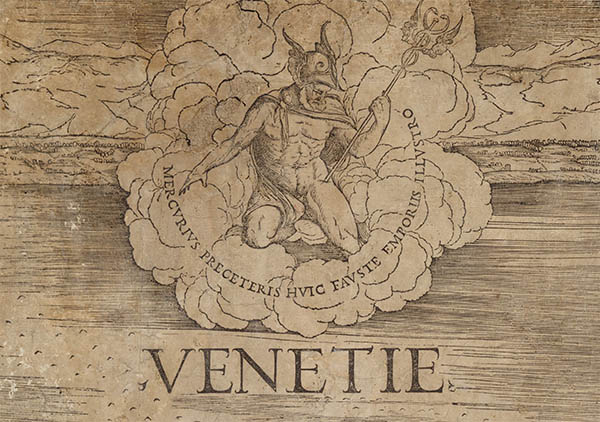
Kolb never stated exactly how Barbari composed the
view, but as Juergen Schultz points out in his classic analysis, it must
have been prepared from dozens, perhaps hundreds of bell tower
sightings:
“... Jacapo’s view is neither a giant landscape drawing made in the field, nor a carefully compiled, foreshortened plan, it can only be a studio fabrication. It must have been assembled mosaic-fashion at the drawing table from a myriad of small view details made from heights throughout the city.” 2
The final plan, which took Barbari at least two
years to complete, shows the city from a vantage point somewhere above
San Giorgio Maggiore. It sweeps outward and upward in a great curve to
the horizon – a perspective that was designed
to be best viewed horizontally, perhaps unrolled across a great table.
Every step in the map’s production was
unprecedented. Kolb obtained six of the largest (as large as 684 × 1000
mm) fine-grained woodblocks ever prepared. Barbari traced his plan on
them and they were then cut by master engravers in Venice or Nuremburg.
The final printing required six sheets of specially commissioned paper
twice the size of an imperial folio, then the largest sheets produced by
any Venetian paper maker.
The result was a monstrous 1.3 × 2.8 m (or nearly 13 ft2) map. Kolb’s capital outlay for the project must have been enormous.
Kolb stated that he was issuing his map “principally for the fama (glory) of this illustrious city of Venice” and in Oct 1500 he appealed to the Venetian government for a copyright
as well as the right to recoup his costs by selling the print for the shocking price of three ducats.3 The Collegio
must have known the nature of the map well in advance;
although it wasn’t cartographically rigorous by modern standards, it was
still accurate enough to aid an invading army. Perhaps out of civic
pride – after all the city was at the height of it’s imperial power –
they gave him a four-year copyright and a tax-free export license:
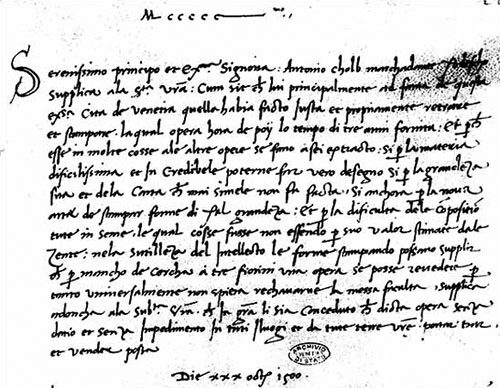
College. Notatorio, register 15, c. 28r. 30 Oct 1500.
Although Barberi played fast-and-loose with
cartographic conventions like perspective and scale he, nevertheless,
included an amount of detail that would literally take years of close
reading to fully appreciate.
He included several hundred place names, several thousand buildings and,
as one commenter wrote, tens of thousands of windows and chimney pots.
As the major sea power of the day he, of course, included every
imaginable type of Venetian ship – from the ever-present gondolas to the
Doge’s 1462 Bucintoro.
He even went so far as to include – perhaps as a cautionary tale – the
former Senate Secretary Antonio Landi, hanging by his neck in Canal de
San Secondo.
It was a stunning achievement and the largest woodblock image for more
than a century.
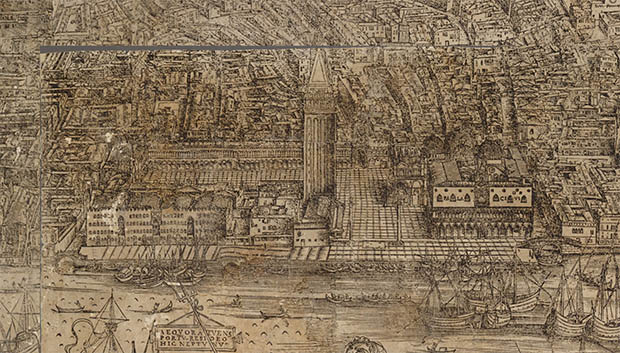
Detail, St. Mark’s Square
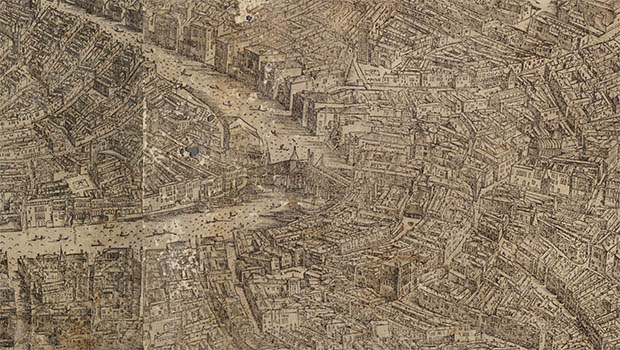
Detail, Rialto Bridge
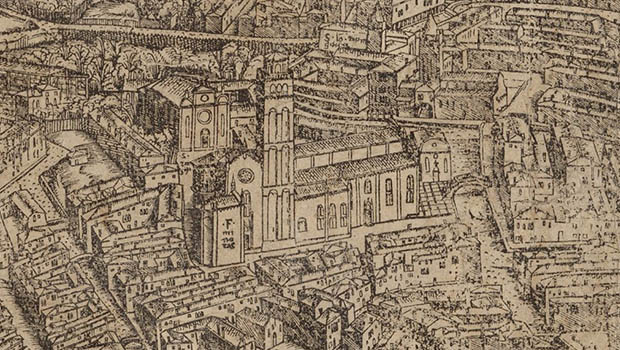
Close detail, Santa Maria dei Frari Monastary
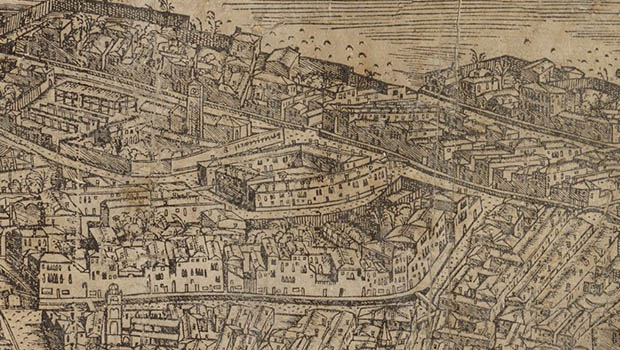
Close detail, Ghetto Nuvo (the Jewish Ghetto)
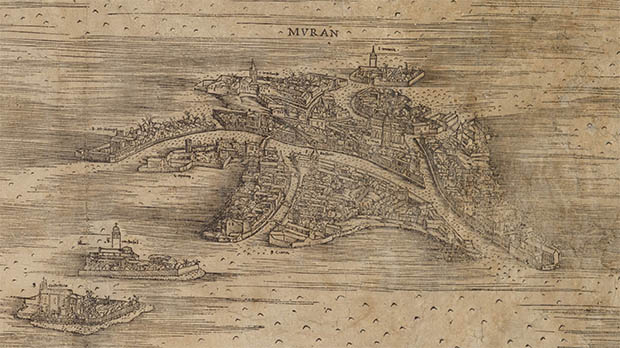
Detail, Murano
By the time the plan was offered for sale in the
autumn of 1500 Barbari had already moved to Nuremburg to work as a
portrait painter and miniaturist for Emperor Maximillian I.
In 1503 he was reported in Wittenburg working for the Great Duke
Frederick of Saxony. In 1504 he again met Dürer where they apparently
discussed drawing human proportion.
By Mar of 1510 he was in the employ of Archduchess Margaret in Brussels.
In Jan 1511 he became ill and in Mar of the same year, the Archduchess
gave him a pension for life on account of his age and weakness.
He died sometime around 1516.
The plan was reprinted, with minor corrections and
updates in 1514 (the example presented here) and again in the late 16th
century.
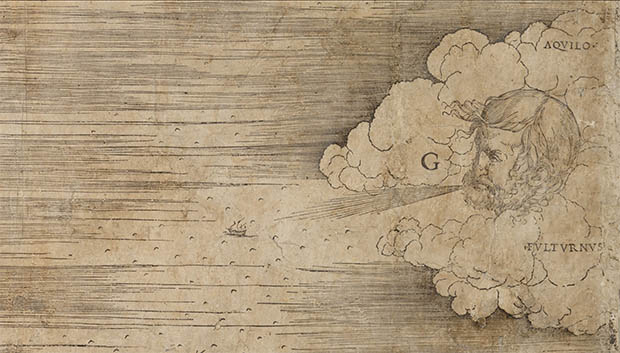
Detail, NE wind putti. The bearded figure may be Barbari’s self-portrait
1. Unless otherwise noted, all the images here are from the ca.1514 second-state copy at the Harry Ransom Center, University of Texas at Austin
(online).
2. Schulz, Juergen. Jacopo de’ Barbari’s View of Venice: Map Making, City Views, and Moralized Geography before the Year 1500. The Art Bulletin. 1978 Sep; 60(3): 425–474
(Jstor). For another analysis see: Howard, Deborah. Venice as a Dolphin: Further Investigations into Jacopo de’ Barbari’s View.
Artibus et Historiae. 1997 18(35): 101–111 (Jstor).
3. The orignal woodblocks (as well as three of the
first-state maps) are now in the collection of the Museo Correr. They
were last used to print sheets of the plan in the 1830s.
No comments:
Post a Comment